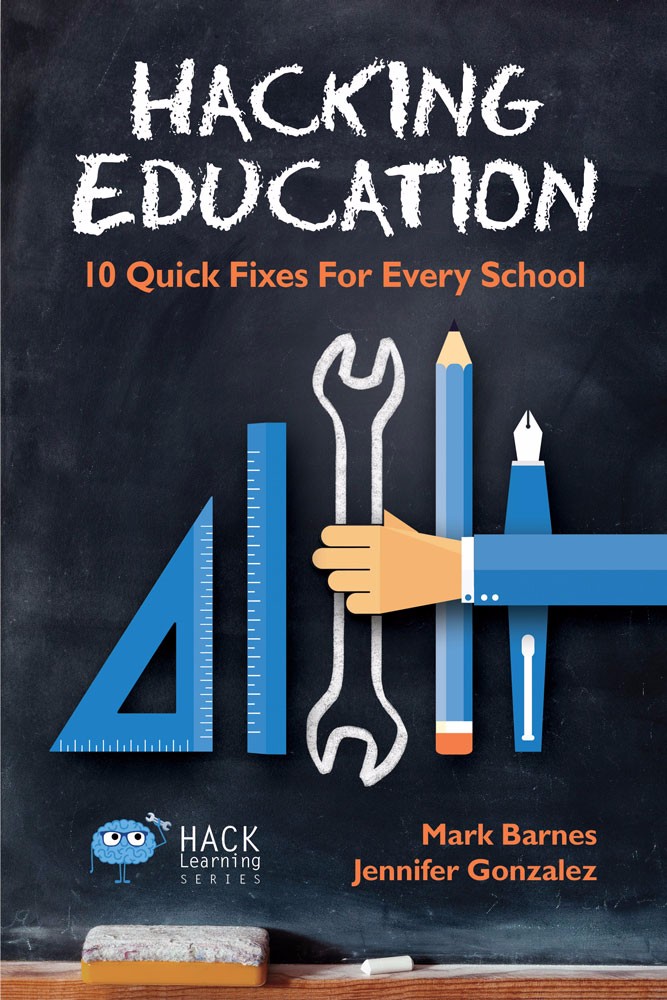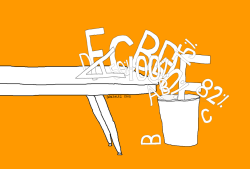
Listen to an Extended Version of this Post in a Podcast (transcript):
This post contains Amazon Affiliate links; if you purchase from Amazon after going through these links, Cult of Pedagogy receives a small commission at no extra cost to you.
One afternoon late last year, my friend Mark Barnes and I were talking about some really creative ways teachers were solving problems in their schools. These ideas were so impressive because they required virtually no money, minimal administrative sign-off, and resources that were already available. And yet these solutions were incredibly powerful, solving problems that had been around for years with just a few small changes.
They reminded us of the Life Hacks we’d seen online, ideas that make you shake your head over how simple and effective they are. The kind of ideas that, when you learn them, you wonder why you never thought of them yourself.
Before long, we decided these ideas had to be shared. Fast-forward to now and the publication of our new book, Hacking Education: 10 Quick Fixes for Every School. In the book, we share 10 fantastic ideas that you can implement without a lot of money, without rounds of committee meetings, without changing policy or fundraising or any of that. You can just do them.
For each hack, we give you a quick overview, describe how you can start putting it into action tomorrow, then follow that up with a blueprint for full implementation of the hack. Next, we talk about the kinds of pushback you’re most likely to get when you introduce this idea in your school and how you can thoughtfully respond to it. Finally, we tell the story of a real educator who is currently using the hack in their own practice.
To give you a small taste of what we offer in this book, I’ll give you a glimpse of the first three hacks right here.
Hack 1: Meetings in the Cloud
Face-to-face meetings consume ridiculous amounts of teacher and administrator time. But they don’t have to; not anymore. Now you can “meet” without having to be in the same place at the same time, giving everyone more flexibility and cutting way back on the time we all spend listening to things that aren’t relevant to us.
Here’s how this hack works: Instead of gathering in a room at a designated time to discuss things, the way you would in a traditional meeting, you’d use a backchannel tool like Voxer or YoTeach, which allow you to have ongoing conversations with large or small groups without having to be in the same place at the same time.
What about handouts? What about paperwork? You’d use a cloud-based storage system like Dropbox or Google Drive to store documents, setting up shared folders that everyone can access. (How do you do that? Watch this quick tutorial on sharing Google Drive folders from Anson Alexander.) The important thing would be to set up a system in which all participants know which documents are for which meeting and what they need to do with them. Setting up a separate sub-folder for each “meeting” can help facilitate that.
Hack 2: Pineapple Charts
Many of us have discovered how much we can grow from observing other teachers. Unfortunately, it’s not easy to get the timing right: You rarely know exactly which teachers are doing what, at what time. Your own limited time complicates this even further—most teachers don’t want to waste a whole planning period going to someone else’s room if they’re not going to get anything out of it.
A Pineapple Chart solves this. Using the pineapple—a traditional symbol of welcome—as a kind of “brand,” the chart is simply a board you hang in the faculty lounge, beside teacher mailboxes, or any place teachers go on a regular basis. On this board is a chart, including all the days of the week and all class periods. Teachers use this chart to advertise interesting things they are doing in their classrooms on specific days or times. For example, if a drama teacher is rehearsing scenes from Our Town Tuesday and Wednesday, he could put that up on the chart. If a science teacher is doing a virtual dissection on Friday morning, she could put that on the chart. When many teachers share their activities, what you get is a big, robust menu of classroom experiences to choose from, open-door lessons other teachers are invited to stop by and see.
Hack 3: Teacher Quiet Zones
Okay, so you have designated teacher planning time on most days, yes? But how much of that time do you actually get to use? Not only do meetings encroach on this time, but countless interruptions can chew up the rest of it. To get a little peace and quiet for productive work, some teachers have resorted to locking their classroom doors, turning off the lights, and working in a corner of the room that can’t be seen through the little square of glass on the door. Even though it feels a bit ridiculous, it works. But what if there were another, more elegant way to accomplish the same goal?
Some schools are starting to create Teacher Quiet Zones, rooms set aside specifically for teachers to get work done. Guidelines are set ahead of time, informing teachers that cell phones and conversations are not welcome in this space, and teachers who are using the Quiet Zone are not to be disturbed except in extremely urgent cases. When these norms are reinforced, teachers are finding these spaces to be a wonderful retreat, not just for getting work done, but also for recharging their batteries for the rest of the school day.
There’s More Where These Came From
In the book, we go into a lot more detail about how to fully implement the above hacks. And these three are just the beginning. The remaining hacks deal with problems like these:
- high teacher turnover
- student discipline
- inadequate tech support
- parents being out of the loop
Hacking Education is a fast read; we worked hard to package each hack in a way that would help you learn it quickly, then run with it. I’m positive that anyone who reads this book will find at least one great idea that they will want to try right away.
Which one will be yours? ♦
Join my mailing list and get weekly tips, tools, and inspiration — in quick, bite-sized packages — all geared toward making your teaching more effective and fun. To thank you, I’ll send you a free copy of my e-booklet, 20 Ways to Cut Your Grading Time in Half.






These are some great ideas, and I’d love it if they were implemented in my school. The problem is that I’m a teacher, and not an administrator and I don’t have any say. (And our PLCs are just mini faculty meetings, a way for administrators to convey info, by the way.) It’s not that our principal is a dictator, far from it, and he’s supportive of us; I think we’re just in a but of a rut, and part of that rut is that administrators run everything on the school level, while teachers do their thing in the classroom. I actually am very lucky to have quite a bit of autonomy in my classroom, and we have an good school, but I believe with more ideas like this in place, we could be excellent. I’d love to suggest these things, but I doubt I’d would be well received. How do you get an administration entrenched in old-style thinking to start being receptive to more teacher input?
Boy is that a tough question. I think a lot of it depends on the individual administrator’s personality. One thing that has worked for me in the past is the “humor me” approach, where instead of attacking a person’s position or asking for a complete overhaul, you start by asking for something small, just to try it out.
So for example, if you wanted your PLC to choose your own focus for professional development, you ask way ahead of time for something like this: “This coming spring, instead of doing _____, we were wondering if we might read x book and collaborate on applying what we learn in our classrooms. Could we try that this one time and see how it goes?” You might also come prepared with a few resources to demonstrate that personalized PD is something a lot of schools are moving toward (like this one: https://www.edsurge.com/n/2015-02-17-how-districts-can-support-the-power-of-personalized-pd).
Try to think of incremental changes you can push for and see how far you get. And never forget the power of a true compliment–if your administrator feels recognized for competence in some areas, he or she will be more open to changing in other ways.